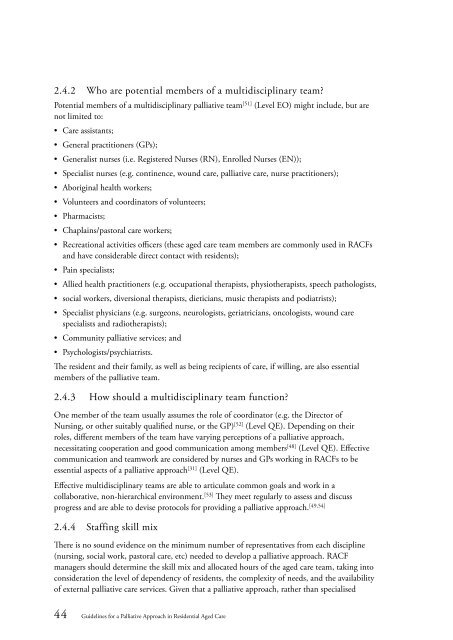Guidelines for a Palliative Approach in Residential Aged Care
Guidelines for a Palliative Approach in Residential Aged Care
Guidelines for a Palliative Approach in Residential Aged Care
Create successful ePaper yourself
Turn your PDF publications into a flip-book with our unique Google optimized e-Paper software.
2.4.2 Who are potential members of a multidiscipl<strong>in</strong>ary team?<br />
Potential members of a multidiscipl<strong>in</strong>ary palliative team [51] (Level EO) might <strong>in</strong>clude, but are<br />
not limited to:<br />
• <strong>Care</strong> assistants;<br />
• General practitioners (GPs);<br />
• Generalist nurses (i.e. Registered Nurses (RN), Enrolled Nurses (EN));<br />
• Specialist nurses (e.g. cont<strong>in</strong>ence, wound care, palliative care, nurse practitioners);<br />
• Aborig<strong>in</strong>al health workers;<br />
• Volunteers and coord<strong>in</strong>ators of volunteers;<br />
• Pharmacists;<br />
• Chapla<strong>in</strong>s/pastoral care workers;<br />
• Recreational activities officers (these aged care team members are commonly used <strong>in</strong> RACFs<br />
and have considerable direct contact with residents);<br />
• Pa<strong>in</strong> specialists;<br />
• Allied health practitioners (e.g. occupational therapists, physiotherapists, speech pathologists,<br />
• social workers, diversional therapists, dieticians, music therapists and podiatrists);<br />
• Specialist physicians (e.g. surgeons, neurologists, geriatricians, oncologists, wound care<br />
specialists and radiotherapists);<br />
• Community palliative services; and<br />
• Psychologists/psychiatrists.<br />
The resident and their family, as well as be<strong>in</strong>g recipients of care, if will<strong>in</strong>g, are also essential<br />
members of the palliative team.<br />
2.4.3 How should a multidiscipl<strong>in</strong>ary team function?<br />
One member of the team usually assumes the role of coord<strong>in</strong>ator (e.g. the Director of<br />
Nurs<strong>in</strong>g, or other suitably qualified nurse, or the GP) [52] (Level QE). Depend<strong>in</strong>g on their<br />
roles, different members of the team have vary<strong>in</strong>g perceptions of a palliative approach,<br />
necessitat<strong>in</strong>g cooperation and good communication among members [48] (Level QE). Effective<br />
communication and teamwork are considered by nurses and GPs work<strong>in</strong>g <strong>in</strong> RACFs to be<br />
essential aspects of a palliative approach [31] (Level QE).<br />
Effective multidiscipl<strong>in</strong>ary teams are able to articulate common goals and work <strong>in</strong> a<br />
collaborative, non-hierarchical environment. [53] They meet regularly to assess and discuss<br />
progress and are able to devise protocols <strong>for</strong> provid<strong>in</strong>g a palliative approach. [49,54]<br />
2.4.4 Staff<strong>in</strong>g skill mix<br />
There is no sound evidence on the m<strong>in</strong>imum number of representatives from each discipl<strong>in</strong>e<br />
(nurs<strong>in</strong>g, social work, pastoral care, etc) needed to develop a palliative approach. RACF<br />
managers should determ<strong>in</strong>e the skill mix and allocated hours of the aged care team, tak<strong>in</strong>g <strong>in</strong>to<br />
consideration the level of dependency of residents, the complexity of needs, and the availability<br />
of external palliative care services. Given that a palliative approach, rather than specialised<br />
44 <strong>Guidel<strong>in</strong>es</strong> <strong>for</strong> a <strong>Palliative</strong> <strong>Approach</strong> <strong>in</strong> <strong>Residential</strong> <strong>Aged</strong> <strong>Care</strong>
















